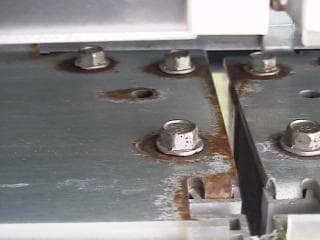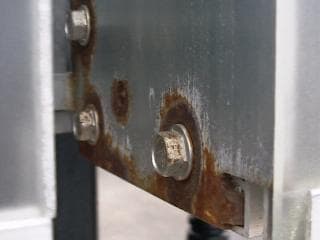
-----
Unknown source of corrosion on plated part
2004
I have an interesting situation that I cannot figure out... We have a part (called an endplate) made from 0.119" THK., C-1018 C.R.S. The endplate has some stainless steel Pem studs in it (FHS-828-8 and FHS-632-8). After the pems are installed, the endplate is deburred and clear zinc plated per QQZ 325Z TYPE 2, CLASS 2 (0.0005 THICK). This is all done at our sheet metal vendor.
When completed in the assembly, the endplate is attached to pieces of aluminum extrusion using self-threading bolts (zinc plated steel) which thread into the extrusion, not the plated part. The bolts are installed using an air ratchet with a fairly high (unmeasured) torque setting.
In the 2-year old endplate that I have pictures of, we are seeing a reddish brown surface corrosion (I assume it to be an oxidation). This corrosion is focused in a somewhat radial pattern around the bolt heads and around the pems. It also is showing up around some part edges. In the field, the endplate is hung via formed tabs onto galvanized Unistrut framing members. All installations are near swimming pools, which have a somewhat high concentration of chlorine in the air. Some are outdoor, some are indoor. In general, this finished assembly has been in service and had this problem for 10+ years, so it is not a new problem.

|

|

|
My hypotheses are:
1. Poor plating job
2. Galvanic corrosion between bolts, pems, and base material
3. Cracked plating due to assembly
4. Poor choice of finish.
Any ideas or thoughts? If more information is needed, please let me know. I would like to know if there are any tests I can run to narrow down the source of the problem.
Thanks,
Carey RyersonOEM Mfg. - Loveland, Colorado, USA
2004
Blatant obvious galvanic corrosion! Too many different kinds of metal reacting galvanically with each other. You may retard the progression by zinc plating all those different metals and applying a heavy olive drab chromate and then dip the chromate in 1/2%/volume Soluble Oil (like the products used on black oxide).
Better still, Cadmium Plate and chromate, but they may not print my letter because of all the furor over eliminating cadmium.

Robert H Probert
Robert H Probert Technical Services
Garner, North Carolina

Ed. note-- Robert: Although finishing.com sometimes edits letters to minimize commercial content, etc., we never censor opinions! We may not agree that cadmium plating is the right solution to this problem, but you're certainly very welcome to suggest that it may be.
Hi Carey,
the problem is the contact of zinc to stainless steel. During corrosion of zinc there is some hydrogen evolution which activates the oxide layer of the stainless steel.
Michael HekliSwitzerland
2004
Q, A, or Comment on THIS thread -or- Start a NEW Thread